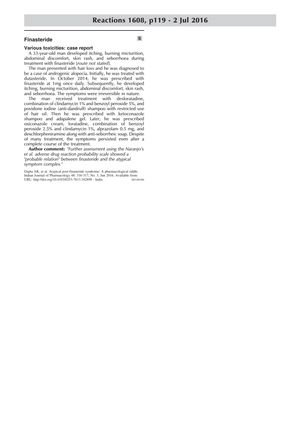TLDR Finasteride can cause itching, burning, and other side effects that may not go away after treatment.
A 33-year-old man experienced various toxicities, including itching, burning micturition, abdominal discomfort, skin rash, and seborrhoea, during treatment with finasteride for androgenic alopecia. Despite receiving various treatments, the symptoms persisted even after a complete course of treatment. The Naranjo's et al. adverse drug reaction probability scale showed a "probable relation" between finasteride and the atypical symptom complex.
8 citations
,
January 2016 in “Indian Journal of Pharmacology” Finasteride and dutasteride can cause severe, lasting side effects.
11 citations
,
October 2021 in “Journal of The European Academy of Dermatology and Venereology” Topical finasteride is an effective and safer treatment for male hair loss.
 13 citations
,
March 2019 in “Journal of Dermatological Treatment”
13 citations
,
March 2019 in “Journal of Dermatological Treatment” Finasteride can treat hair loss, but may have side effects; evaluate and inform patients of risks.
 12 citations
,
October 2004 in “PubMed”
12 citations
,
October 2004 in “PubMed” Finasteride, especially in a 1mg dose, effectively slows hair loss and improves hair growth in Japanese men with male pattern hair loss.
 10 citations
,
June 2001 in “PubMed”
10 citations
,
June 2001 in “PubMed” Finasteride is effective in growing hair and stopping hair loss in men with mild to moderate alopecia.
July 2000 in “Hair transplant forum international”  3 citations
,
August 1996 in “PubMed”
3 citations
,
August 1996 in “PubMed” Finasteride reduces prostate size and serum levels, helping manage benign prostatic hyperplasia, without affecting prostate cancer detection. Regular monitoring is needed for users.




